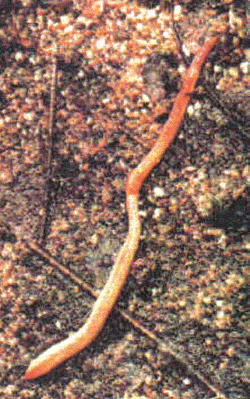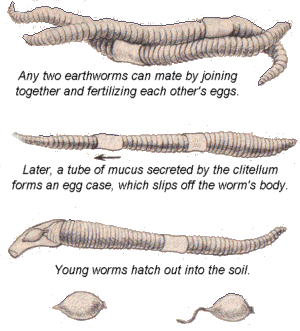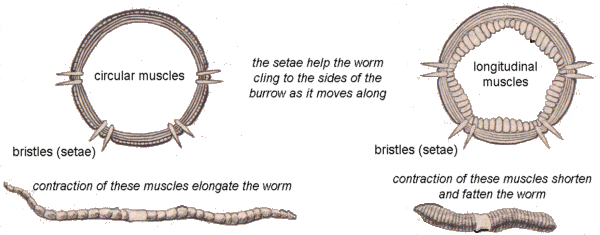


 Common Earthworm
Common Earthworm(Night Crawler)
Lumbricus terrestris
Description
The night crawler may be up to 10 inches long. The body is divided into 150 ring-like segments. The mouth is at the tapering front end, which is usually slightly darker than the rest of the body; the tail end tends to be more flattened than the head and lighter in color.
Its reddish tinge is due to the oxygen-carrying pigment hemoglobin in the blood.
Habitat
Earthworms occur in the highest numbers in grassland, where there is plenty of food and no disturbance. Populations decline drastically if the ground is plowed or dug. Moist soils rich in organic matter are the preferred habitat.
Diet
Night crawlers eat a variety of organic matter, including dead leaves and other plant debris, soil micro-organisms (protozoa, nematodes, bacteria, fungi, etc.), and the remains of larger dead animals. Some food is taken in with soil swallowed in burrowing, but vegetation lying on the ground is the most important source.
Benefit to Agriculture
Earthworms move an incredible amount of soil as they burrow and feed. There may be as many as 3 million earthworms per acre of soil, and it has been estimated that 7½ to 18 tons of soil can be thrown up by earthworms per acre per year.
 Reproduction
Reproduction
Earthworms are hermaphroditic, meaning that each individual worm contains both male and female reproductive organs. However, the worms must still mate with another in order to reproduce. When two worms mate, they lie alongside one another, and both transfer sperm to the other. Egg-laying begins about a day after mating and may continue for several months afterward. As the eggs are laid they become enclosed in a cocoon and are fertilized by stored sperm. Each cocoon contains several eggs, but in most cases only one or two embryos survive. Young worms emerge after one to five months (the length of time varies according to environmental conditions), and are ready to reproduce after another six to eighteen months.
Movement
Earthworms move along by waves of muscular contraction traveling back along the body. Extra grip is given by short, backwardly-pointing bristles (setae), which can be pushed out as required. There are four pairs of setae on each segment, except the first and last. The setae also serve to anchor the worm in its burrow, which is why it can be extremely difficult to pull a worm out of the ground.

Scientific Classification
phylum Annelida
class Oligochaeta
order Haplotaxida
suborder Lumbricina
family Lumbricidae
genus & species Lumbricus terrestris
Questions or comments about this page?
![]()
Molly McLaughlin. Earthworms, Dirt, and Rotten
Leaves. New York:Avon Books, 1986.
SKC Films Library
Science.--Zoology.--Invertebrates.--Phylum Annelida.--Class Oligochaeta (Earthworms).
Search This Site | Usage Guidelines | About the Library | Contact Information | Navigation Help